Challenger 2
The FV4034 Challenger 2 (MOD designation "CR2") is a third generation British main battle tank (MBT) in service with the armies of the United Kingdom and Oman. It was designed and built by the British company Vickers Defence Systems (now known as BAE Systems Land & Armaments).[7]
| FV 4034 Challenger 2 | |
|---|---|
 A Challenger 2 tank patrolling outside Basra, Iraq, during Operation Telic | |
| Type | Main battle tank |
| Place of origin | United Kingdom |
| Service history | |
| In service | 1998–present |
| Used by | British Army, Oman Army |
| Wars | Iraq War |
| Production history | |
| Manufacturer | Alvis plc, BAE Systems Land & Armaments |
| Unit cost | £4,217,000[1] |
| Produced | 1993–2002 |
| No. built | ≈ 447 |
| Specifications | |
| Mass | 62.5 tonnes (61.5 long tons; 68.9 short tons), with a combat ready weight of 75.0 tonnes (73.8 long tons; 82.7 short tons) with add-on armour modules. |
| Length | 8.3 m (27 ft 3 in), 13.50 m (44 ft 3 in) with gun forward |
| Width | 3.5 m (11 ft 6 in), 4.2 m (13 ft 9 in) with appliqué armour |
| Height | 2.49 m (8 ft 2 in) |
| Crew | 4 (commander, gunner, loader/operator, driver) |
| Armour | Chobham / Dorchester Level 2 (classified) |
Main armament | L30A1 120 mm rifled gun with 47 rounds [2][3] |
Secondary armament | Coaxial 7.62 mm L94A1 chain gun EX-34 (chain gun), 7.62 mm L37A2 Operator/Loader's hatch machine gun |
| Engine | Perkins CV12-6A V12 diesel 26.1 litre 1,200 bhp (890 kW) |
| Power/weight | 19.2 hp/t (14.3 kW/t) at 62.5t, 16.0 hp/t (11.9 kW/t) at 75.0t. |
| Transmission | David Brown TN54E epicyclic transmission (6 fwd, 2 rev.) |
| Suspension | Hydropneumatic suspension |
| Ground clearance | 0.5 m (1 ft 8 in)[4] |
| Fuel capacity | 1,592 litres (350 imp gal; 421 US gal)[4] |
Operational range | 550 km (340 mi) on road,[5] 250 km (160 mi) off road on internal fuel[4] |
| Maximum speed | 59 km/h (37 mph) on road,[6] 40 km/h (25 mph) off road[4] |
Vickers Defence Systems began to develop a successor to Challenger 1 as a private venture in 1986. A £90 million deal for a demonstrator vehicle was finalised in January 1989. In June 1991, the Ministry of Defence placed a £520 million order for 140 vehicles, with a further 268 ordered in 1994. Production began in 1993 and the unit's tanks were delivered in July 1994, replacing the Challenger 1. The tank entered service with the British Army in 1998, with the last delivered in 2002. It is expected to remain in service until 2035. The Royal Army of Oman ordered 18 Challenger 2s in 1993 and a further 20 tanks in November 1997.
The Challenger 2 is an extensive redesign of the Challenger 1. Although the hull and automotive components seem similar, they are of a newer design and build than those of the Challenger 1 and only around 3% of components are interchangeable.[8] A visual recognition feature is the armoured housing for the TOGS thermal gunsight: the Challenger 2 has this above the gun barrel, the Challenger 1 has it at the right hand side of the turret. The tank's drive system provides a 550 km range, with a maximum road speed of 59 km/h.
The Challenger 2 is equipped with a 120-millimetre (4.7 in) 55-calibre long L30A1 tank gun,[9] the successor to the L11 gun used on the Chieftain and Challenger 1. Unique among NATO main battle tank armament, the L30A1 is rifled, because the British Army continues to place a premium on the use of High-explosive squash head (HESH) rounds in addition to armour-piercing fin-stabilised discarding-sabot rounds. The Challenger 2 is also armed with a L94A1 EX-34 7.62 mm chain gun and a 7.62 mm L37A2 (GPMG) machine gun. Fifty main armament rounds[10] and 4,200 rounds of 7.62 mm ammunition are carried.
The Challenger 2 has a four-man crew. The turret and hull are protected with second generation Chobham armour (also known as Dorchester). On one occasion, in August 2006, during the post-invasion stage of the Iraq War, an RPG-29 was fired at a Challenger 2 that was climbing over a ramp. The armour on its front underside hull, which was augmented with an explosive reactive armour package, was damaged, injuring several crew members. The tank subsequently returned to base under its own power and was quickly repaired and back on duty the following day.[11] As a response to the incident, the explosive reactive armour package was replaced with a Dorchester block and the steel underbelly lined with armour as part of the 'Streetfighter' upgrade.[12] To date, the only time the tank has been destroyed during operations was by another Challenger 2 in a 'blue on blue' (friendly fire) incident at Basra in 2003 when the destroyed tank had its hatch open at the time of the incident.
It has seen operational service in Bosnia and Herzegovina, Kosovo and Iraq.
History
The Challenger 2 is the third vehicle of this name, the first being the A30 Challenger, a World War II design using the Cromwell tank chassis with a 17-pounder gun. The second was the Persian Gulf War era Challenger 1, which was the British army's main battle tank (MBT) from the early 1980s to the mid-1990s.
Vickers Defence Systems began to develop a successor to Challenger 1 as a private venture in 1986. Following the issue of a Staff Requirement for a next-generation tank, Vickers submitted its plans for Challenger 2 to the Ministry of Defence (MoD). They evaluated the American M1 Abrams offered by General Dynamics, but the Thatcher government chose to proceed with the Challenger 2 in December 1988.[13] Secretary of State for Defence George Younger announced to the House of Commons that Vickers would receive a £90 million contract for a demonstrator vehicle, a deal that was finalised in January 1989.[14] The demonstration phase had three milestones for progress, with dates of September 1989, March 1990, and September 1990. At the last of these milestones, Vickers was to have met 11 key criteria for the tank's design.[14]
In June 1991, after competition with other tank manufacturers' designs (including the M1A2 Abrams and the Leopard 2 (Improved)), the MoD placed a £520 million order for 127 MBTs and 13 driver training vehicles. An order for a further 259 tanks and 9 driver trainers (worth £800 million) was placed in 1994. Oman ordered 18 Challenger 2s in 1993 and a further 20 tanks in November 1997.
Production began in 1993 at two primary sites: Elswick, Tyne and Wear and Barnbow, Leeds, although over 250 subcontractors were involved. The first tanks were delivered in July 1994.
The Challenger 2 failed the acceptance trials in 1994 and it was forced into the Progressive Reliability Growth Trial in 1995. Three vehicles were tested for 285 simulated battlefield days. Each day consisted of:
- 27 km (17 mi) of on-road travel
- 33 km (21 mi) of off-road travel
- 34 main armament rounds fired
- 1,000 7.62 MG rounds fired
- 16 hours weapon system operation
- 10 hours main engine idling
- 3.5 hours main engine running
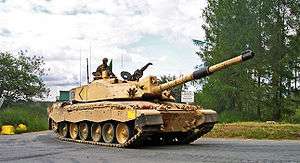
The tank was then accepted into service in 1998. An equally important milestone was the In-Service Reliability Demonstration (ISRD) in 1998. The CR2 In-Service Reliability Demonstration (ISRD) milestone was successfully achieved in January 1999. The ISRD took place from September to December 1998. 12 fully crewed tanks were tested at the Bovington test tracks and at Lulworth Bindon ranges. The tank exceeded all staff requirements.
The Challenger 2 entered service with the British Army in June 1998 (with the Royal Scots Dragoon Guards), with the last delivered in 2002. Under Army 2020, only three Challenger 2 Tank Regiments will remain: the Queen's Royal Hussars, the King's Royal Hussars and the Royal Tank Regiment, each of which is the tank Regiment of an Armoured Infantry Brigade. A single Army Reserve regiment, The Royal Wessex Yeomanry, will provide reservist Challenger crews to the regular regiments.
Deliveries of the Challenger 2 to Oman were completed in 2001.
The Trojan minefield breaching vehicle and the Titan bridge-laying vehicle based on the chassis of the Challenger 2 were shown in November 2006; 66 are to be supplied by BAE Systems to the Royal Engineers, at a cost of £250 million.[15]
A British military document from 2001 indicated that the British Army would not procure a replacement for the Challenger 2 because of a lack of foreseeable conventional threats in the future.[16] However, IHS Jane's 360 reported on 20 September 2015 that following discussions with Senior Army Officers and Procurement Officials at DSEI 2015, as well as the head of the British Army, General Sir Nick Carter, that the British Army was looking at either upgrading the Challenger 2 or outright replacing it. Sources confirmed that the future of the MBT was being considered at the highest levels of the Army. This stemmed from the British Army's concern with the new Russian T-14 Armata main battle tank and the growing ineffectiveness of the aging L30 rifled gun and its limited suite of ammunition. Further, it was confirmed that numerous armoured vehicle manufacturers had discussions with the MoD about a potential replacement for the Challenger 2.[17] Shortly after, the British Army decided that purchasing a new tank would be too expensive and chose to proceed with a Challenger 2 life extension project (LEP).[18] It is expected to remain in service until 2025.[19] Maintenance and overhaul of the Challenger 2's is currently undertaken by Babcock Defence Support Group, and design authority for the tank is held by BAE Systems.[20][21]
Design
Armament
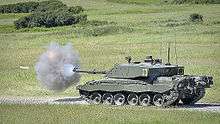
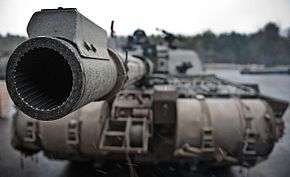
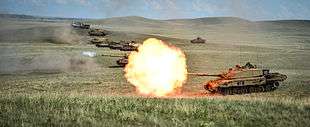
The Challenger 2 is equipped with a 120-millimetre (4.7 in) 55-calibre long L30A1 tank gun,[9] the successor to the L11 gun used on Chieftain and Challenger 1. The gun is made from high strength electro-slag remelting (ESR) steel with a chromium alloy lining and, like earlier British 120 mm guns, it is insulated by a thermal sleeve. It is fitted with a muzzle reference system and fume extractor, and is controlled by an all-electric control and stabilization system. The turret has a rotation time of 9 seconds through 360 degrees.
Uniquely among NATO main battle tank armament, the L30A1 is rifled and along with its predecessor, Royal Ordnance L11A5, the only Third Generation Main Battle Tank Guns to use a rifled barrel. This is because the British Army continues to place a premium on the use of high explosive squash head (HESH) rounds in addition to Armour-piercing fin-stabilized discarding-sabot rounds. HESH rounds have a longer range (up to 8 kilometres or 5 miles further) than APFSDS, and are more effective against buildings and thin-skinned vehicles.[22]
Forty-nine main armament rounds are carried in the turret and hull; these are a mix of L27A1 APFSDS (also referred to as CHARM 3), L31 HESH and L34 white phosphorus smoke rounds, depending on the situation. As with earlier versions of the 120 mm gun, the propellant charges are loaded separately from the shell or KE projectile. A combustible rigid charge is used for the APFSDS rounds and a combustible hemispherical bag charge for the HESH and Smoke rounds. An electrically fired vent tube is used to initiate firing of the main armament rounds. (The main armament ammunition is thus described to be "three-part ammunition", consisting of the projectile, charge and vent tube.) The separation of ammunition pieces also aids in ensuring lower chances of ammunition detonation.
The Challenger 2 is also armed with a L94A1 EX-34 7.62 mm chain gun coaxially to the left of the main gun, and a 7.62 mm L37A2 (GPMG) machine gun mounted on a pintle on the loader's hatch ring. 4,200 rounds of 7.62 mm ammunition are carried. The Challenger can also mount a Leonardo "Enforcer" remote control weapons system bearing a 7.62 mm L37A2 (GPMG) machine gun, a 12.7mm heavy machine gun or a 40mm automatic grenade launcher.[23]
Fire control and sights
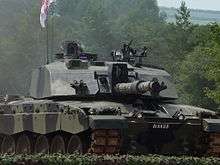
The digital fire control computer from Computing Devices Co of Canada contains two 32-bit processors with a MIL STD1553B databus, and has capacity for additional systems, such as a Battlefield Information Control System.
The commander has a panoramic SAGEM VS 580-10 gyrostabilised sight with laser rangefinder. Elevation range is +35° to −35°. The commander's station is equipped with eight periscopes for 360° vision.
The Thermal Observation and Gunnery Sight II (TOGS II), from Thales, provides night vision. The thermal image is displayed on both the gunner's and commander's sights and monitors. The gunner has a stabilised primary sight using a laser rangefinder with a range of 200 m (660 ft) to 10 km (6.2 mi). The driver's position is equipped with a Thales Optronics image-intensifying Passive Driving Periscope (PDP) for night driving and a rear view thermal camera.
Protection

The Challenger 2 is a heavily armoured and well protected tank.[24] The turret and hull are protected by second generation of Chobham armour (also known as Dorchester), the details of which are classified but which is said to be more than twice as strong as steel. Crew safety was paramount in the design, using a solid state electric drive for its turret and gun movement, thus removing the traditional risk of hydraulic rupture into the crew compartment. Explosive reactive armour kits are also fitted as necessary along with additional bar armour. The nuclear, biological and chemical (NBC) protection system is located in the turret bustle. The tank's shape is also designed to minimise its radar signature. On each side of the turret are five L8 smoke grenade dischargers. The Challenger 2 can also create smoke by injecting diesel fuel into the exhaust manifolds.
Drive system
The tank's drive system comprises:
- Engine: Perkins 26.1 litre, 60° Vee, twin turbo-charged, CV12-6A four-stroke, four valve per cylinder (pushrod), direct injection diesel engine delivering 1200 bhp (895 kW) at 2300rpm. Torque 4126 Nm at 1700rpm.[25] The engine and gearbox are controlled by a Petards Vehicle Integrated Control System (VICS).[26]
- Gearbox: David Brown Santasalo TN54E epicyclical transmission (6 fwd, 2 rev.) rated at 1200 bhp and upgradable to 1500 bhp.[27]
- Suspension: Horstman Defence Systems second (current) or third-generation (future) hydrogas suspension units (HSU).[28][29]
- Track: William Cook Defence hydraulically adjustable TR60 414FS double-pin.[30]
- Maximum speed: 37 mph (60 km/h) on road; 25 mph (40 km/h) cross country
- Range: 342 mi or 550 km on road with external fuel; 156 mi (250 km) cross country on internal fuel.
The tank is also fitted with an Extel Systems Wedel APU (Auxiliary Power Unit - also referred to as a GUE [Generating Unit Engine]) based around a 38 kW Perkins P404C-22 Diesel engine, with a 600 A electrical output which can be used to power the vehicle's electrical systems when it is stationary and the main engine is switched off, this replaces the Perkins P4.108 engine fitted when the tank was first introduced.[31] The use of an APU allows for reduced fuel consumption and lowers the audio and thermal signature of the vehicle.
As of 2013, the British Army has, at various events featuring the Challenger 2, begun to state the on road range of 550 km as opposed to an earlier stated value of 450 km.[5] They have also publicly stated a maximum road speed of 59 km/h while equipped with 15 tons of additional modules.[5]
Crew and accommodation
The British Army maintained its requirement for a four-man crew (including a loader) after risk analysis of the incorporation of an automatic loader suggested that auto-loaders reduced battlefield survivability. Mechanical failure and the time required for repair were prime concerns.
Similar to every British tank since the Centurion, and most other British AFVs, Challenger 2 contains a boiling vessel (BV) for water, which can be used to brew tea, ramen or produce other hot beverages and heat boil-in-the-bag meals contained in field ration packs.[32] This BV requirement is general for armoured vehicles of the British Armed Forces, and is unique to the armed forces of the UK and India.
Operational history
MOD Spokesman, speaking in regard to the Challenger 2[33]
The Challenger 2 had been used in peacekeeping missions and exercises before, but its first combat use came in March 2003 during the invasion of Iraq. 7th Armoured Brigade, part of 1st Armoured Division, was in action with 120 Challenger 2s around Basra. The type saw extensive use during the siege of Basra, providing fire support to the British forces and knocking out Iraqi tanks, mainly T-54/55s. The problems that had been identified during the large Saif Sareea II exercise, held 18 months earlier, had been solved by the issuing of Urgent Operational Requirements for equipment such as sand filters and so during the invasion of Iraq the tank's Operational availability was improved.
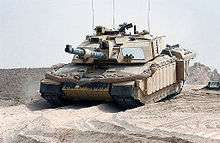
During the 2003 invasion of Iraq, the Challenger 2 tanks suffered no tank losses to Iraqi fire, although one was penetrated by an Improvised explosive device (IED). This was, at the time, unprotected by Dorchester armour. The driver was injured. In one encounter within an urban area, a Challenger 2 came under attack from irregular forces with machine guns and rocket propelled grenades. The driver's sight was damaged and while attempting to back away under the commander's directions, the other sights were damaged and the tank threw its tracks entering a ditch. It was hit by 14 rocket propelled grenades from close range and a MILAN anti-tank missile.[34] The crew survived, safe within the tank until it was recovered for repairs, the worst damage being to the sighting system. It was back in operation six hours later. One Challenger 2 operating near Basra survived being hit by 70 RPGs in another incident.[35]
In August 2006 south east of al-Amarah, southern Iraq, an RPG-29 capable of firing a tandem-charge penetrated the frontal lower underbelly armour of a Challenger 2 commanded by Captain Thomas Williams of The Queens's Royal Hussars. The tank, which had already been hit by 10–15 RPGs, small arms and sniper fire, was attempting to draw fire away from another callsign that had become stricken. Its driver, Trooper Sean Chance, lost part of his foot in the blast; two more of the crew were slightly injured. Chance was able to reverse the vehicle 1.5 mi (2.4 km) to the regimental aid post despite his injuries. The incident was not made public until May 2007; in response to accusations that crews had been told the tank was impervious to the insurgents' weapons, the MoD said "We have never claimed that the Challenger 2 is impenetrable."[11] Since then, the explosive reactive armour has been replaced with a Dorchester block and the steel underbelly lined with armour as part of the 'Streetfighter' upgrade as a direct response to this incident.
Two Challenger 2s have been damaged in combat, but only one has been destroyed:
- 25 March 2003: A friendly fire ("blue-on-blue") incident in Basra in which one Challenger 2 of the Black Watch Battlegroup (2nd Royal Tank Regiment) mistakenly engaged another Challenger 2 of the Queen's Royal Lancers after detecting what was believed to be an enemy flanking manoeuvre on thermal equipment. The attacking tank's second HESH round hit the open commander's hatch lid of the QRL tank sending hot fragments into the turret, killing two crew members. The hit caused a fire that eventually led to an explosion of the stowed ammunition, destroying the tank. It remains the only Challenger 2 to be destroyed on operations.[36][37]
- 6 April 2007: in Basra, Iraq, a shaped charge from an IED penetrated the underside of a tank resulting in the driver losing three of his toes and causing minor injuries to another soldier.[38][39]
.jpg)
To help prevent incidents of this nature, Challenger 2s have been upgraded with a new passive armour package, including the use of add-on armour manufactured by Rafael Advanced Defense Systems of Israel.[40] When deployed on operations the Challenger 2 is now normally upgraded to TES (Theatre Entry Standard), which includes a number of modifications including armour and weapon system upgrades.
Upgrades
CLIP
The Challenger Lethality Improvement Programme (CLIP) was a programme to replace the current L30A1 rifled gun with the smoothbore Rheinmetall 120 mm gun currently used in the Leopard 2A6. The use of a smoothbore weapon would have allowed Challenger 2 to use NATO standard ammunition developed in Germany and the US. This includes tungsten-based kinetic energy penetrators, which do not have the same political and environmental objections as depleted uranium rounds. The production lines for rifled 120 mm ammunition in the UK have been closed for some years, so existing stocks of ammunition for the L30A1 are finite.[41] In 2009, a new HESH round manufactured in Belgium by Mecar has been trialled. This means that the Challenger 2 now has available new Tungsten "FIN" (APFSDS) and HESH rounds, if and when required, which secures a line of ammunition for its 55 calibre rifled main gun, the L30, when required in the future.
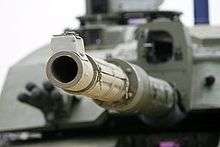
A single Challenger 2 was fitted with the L55 and underwent trials in January 2006.[42] The smoothbore gun is the same length as the L30A1, and is fitted with the rifled gun's cradle, thermal sleeve, bore evacuator and muzzle reference system. Early trials apparently revealed that the German tungsten DM53 round was more effective than the depleted-uranium CHARM 3.[24] The ammunition storage and handling arrangements will need to be changed to cater for the single-piece smoothbore rounds, instead of the separate-loading rifled rounds. In 2006, a figure of £386 million was estimated to fit all Challengers in the British Army with the Rheinmetall 120 mm gun.[41]
CSP
Other improvements have also been considered, including a regenerative NBC protection system.[43] In addition, several Challenger 2s had the pintle-mounted GPMG on the loader's crew hatch replaced with a remote controlled turret, allowing the loader to operate the weaponry without having to expose himself to enemy fire.
In May 2007, the Ministry of Defence's Future Systems Group invited BAES to tender for the Challenger 2 Capability Sustainment Program (C2 CSP), which combined all upgrades into one programme. However, by mid-2008, the programme was in danger of slipping, or even being cancelled, as a result of defence budget shortfalls.[44]
CLEP
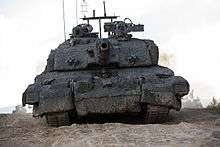
The Challenger 2 Life Extension Programme (LEP) is designed to replace obsolete equipment, enhance protection, increase range and provide improved lethality of the tank until an out of service date of 2035 - extending its life from 2025.[45][46] The LEP forms the major component of the "Armour MBT (2025) Programme".[47][48] In July 2013, it was confirmed that the Challenger 2 Life Extension Programme (LEP) was in the concept stage and would be in initial gate by 2014,[49] this later slipped to early 2015. In June 2014, it was stated that not all of the 227 Challenger 2s may be modified to CLEP standard and the smoothbore cannon had been dropped.[50]
A Royal Tank Regiment (RTR) Newsletter dated December 2015 stated that the LEP includes managing to curb obsolescence in several turret systems – including TI sights, the Fire Control Computer (FCC) and electronic architecture in turret. Improved technology will be integrated as a new system on the platform, which will deliver more accurate engagements at range and improved FCC power, meaning that CR2 will remain a "battle winning" asset out to the extended out of service date. Parallel work strands will provide extensions to virtual training systems, deliver improved Live Fire Monitoring Equipment (LFME) and work is ongoing to develop improved 120 mm ammunition.[51] The full scope of the LEP is indicated as being broken down into four areas:
- Surveillance and Target Acquisition: Updated Commanders Primary Sight, Updated Gunners Primary Sight, Replacement Thermal Observation and Gunnery Sights (TOGS) and, 3rd Generation Thermal Imaging (TI).
- Weapon Control System: Fire Control Computer (FCC), Fire Control Panel (FCP) and, Gun Processing Unit (GPU)
- Mobility (Through In-Service Efficiencies): 3rd Generation (Horstman) Hydrogas Suspension, Improved Air Filtration, CV-12 Common Rail Fuel Injection, Transmission and, Cooling.
- Electronic Architecture (Modernised Electronics): Gunners Control Handles, Video Distribution Architecture, Generic Vehicle Architecture (GVA) Compliant Interfaces, Increased On-board Processing and, Improved Human Machine Interface (HMI).
A recent Ministry of Defence document also identified a "soft kill defensive aid system", the German MUSS, for the Challenger 2.[52] Active Protection Systems (APS) for armoured vehicles in the UK armed forces (including the Challenger 2) are being assessed by the UK Defence Science and Technical Laboratory (DSTL) as part of the MEDUSA Technical Assessment Programme, this includes the MUSS System.[53] In 2017 a Challenger 2 was also fitted with a Rheinmetall ROSY rapid obscurant system including parts from the Israeli Military Industries (IMI) Iron Fist Hard-Kill APS for development and assessment by the DSTL.[54]
In January 2016 it was reported by IHS Jane's that the UK's Defence Equipment and Support (DE&S) organisation had received a number of replies to its pre-qualification questionnaire (PQQ) for the projected Challenger 2 MBT life extension programme (LEP) which aims to extend the life of the Challenger 2 out to 2035. In addition to BAE Systems Combat Vehicles (UK), which is the original equipment manufacturer (OEM), contenders were stated to include Rheinmetall and Krauss-Maffei Wegmann of Germany, General Dynamics Land Systems UK, Lockheed Martin UK, CMI Defence of Belgium, and RUAG Defence of Switzerland.[55]
Around this time a separate two-year contract was awarded to BAE Systems and Krauss Maffei Wegmann to develop an update to the bridging variant in part to address the increase in weight of the Challenger 2 from 62.5t to 75t arising from upgrades made during the Iraq campaign.[56]
Final bids for the upgrade programme were submitted in August 2016. The LEP will see the replacement of most of the tanks electronics, including its sighting systems but does not envisage a major upgrade of the vehicle's drive systems or replacement of the 120 mm L30A1 rifled gun. Full bidder confirmation was not available at this time.[57]
On 2 November 2016 it was reported that teams led by Rheinmetall Landsystem and BAE Systems had been chosen as preferred bidders for the assessment phase of the LEP by the UK MoD. The MoD are investing £53 million in the assessment phase. Each contractor receives £23 million, with an additional £7 million being set aside to cover additional, unspecified work. The Rheinmetall consortium includes BMT, Pearson Engineering, Supacat, and Thales UK and includes an option to retrofit Rheinmetall's 120 mm L55 smooth bore gun should additional funds be made available. The BAE team includes General Dynamics UK, Qinetiq, Leonardo, Moog and Safran.[58] Also bidding for the LEP were teams headed by CMI Defence (Belgium), Krauss-Maffei Wegmann (Germany), Lockheed Martin UK, and RUAG Defence (Switzerland).[59] It is expected the LEP modernization program could be worth around £650 million ($802 million) to the eventual winner.[58] On 22 December 2016, an assessment phase award was awarded to BAE Systems and Rheinmetall Land Systeme GmbH to progress the Challenger 2 Life Extension Project.[60] In order to maintain the effectiveness of the Thermal Imaging System prior to the award and implementation of the CR2 LEP, an interim £15.4 million "Challenger 2 Thermal imaging sustainment project" was awarded to BAE Systems on 15 December 2017 to "demonstrate and manufacture" a suitable interim solution separate to that incorporated in the LEP.[61] In October 2019 it was announced that Thales would be supplying their Catherine Megapixel (MP) Thermal Imaging Camera which forms part of the Thermal Imaging Sub-System on the Tank.[62]
In October 2018, BAE Systems unveiled its proposed Challenger 2 LEP technology demonstrator, the “Black Night”. The new improvements include a Safran Paseo commander’s independent sight, Leonardo thermal imager for the gunner, and Leonardo night sight DNVS 4. The Black Night Challenger 2 turret has been modified to improve the speed of traverse and provides greater space as well as regenerative braking to generate and store power. Other enhancements include a laser warning system and an active protection system.[63][64]
In January 2019 Rheinmetall unveiled details of its proposal for the Challenger 2 LEP. The company’s solution has been to develop a completely new turret which has a fully digital electronic architecture, new day and night sights for the commander and gunner, and a Rheinmetall L55 smoothbore 120 mm gun. The turret was developed on Rheinmetall’s own initiative and was not funded by the UK MoD for the LEP assessment phase. The smoothbore gun was not part of the MoD’s LEP requirement, with the request for proposals focusing on mission system obsolescence. The Rheinmetall proposal is ambitious and is likely to be significantly more expensive than the BAE Systems’ offering unveiled in 2018. However, the new turret is necessary if a smoothbore gun is selected. If Rheinmetall’s planned purchase of a 55% stake in BAE Systems’ UK operations is approved the LEP competition between the companies will continue, an agreement with Rheinmetall ensuring that the solution will be delivered from Telford regardless of the contract winner.[65][66][67][68]
In September 2019 a Challenger hull equipped with a new unmanned turret, Autoloader mechanism and the Rheinmetall 130mml/51 was unveiled as a possible response to the Armarta, Rheinmetall also stated they are currently developing a new APFSDS round for the gun expecting it to increase the penetration capabilities of the Challenger by at least half.
HAAIP
Options for updating the automotive components of Challenger 2, and its associated variants, are being analysed separately from CLEP as part of the Heavy Armour Automotive Improvement Programme (HAAIP).[69] HAAIP has already led to upgrades to the air filtration system, through the use of cleanable air filters with increased operating life, which were tested in Exercise Saif Sareea 3 in October 2018.[70]
The HAAIP programme, awarded to BAE Systems will also apply a common engine (CV12-8A) and suspension standard to Challenger 2, CRARRV, Titan and Trojan improving reliability.[71]
With regard to the powertrain, BAE Systems are evaluating whether to uprate the existing CV12 engine or swap this for alternative designs. The CV12 upgrade by Caterpillar Defense would fit electronically controlled common rail fuel injection and introduce engine health monitoring (HUMS). This would increase the maximum power output to 1,500 bhp, reduce battlefield smoke emissions, and improve fleet reliability and availability.[72] The engines and transmission units have themselves also been remanufactured in recent years.[73][74]
Variants
Titan
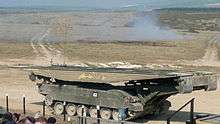
The Titan armoured bridge layer is based on aspects of the Challenger 2 running gear and replaced the Chieftain Armoured Vehicle Launched Bridge (ChAVLB). The Titan came into service in 2006 with the Royal Engineers, with 33 in service. Titan can carry a single 26-metre-long bridge or two 12-metre-long bridges. It can also be fitted with a bulldozer blade.
Trojan
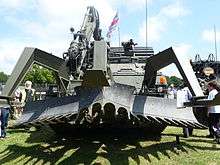
The Trojan Armoured Vehicle Royal Engineers is a combat engineering vehicle designed as a replacement for the Chieftain AVRE (ChAVRE). It uses the Challenger 2 chassis, and carries an articulated excavator arm, a dozer blade, and attachment rails for fascines. Entering service in 2007, 33 were produced.
Challenger 2E
The Challenger 2E is an export version of the tank. It has a new integrated weapon control and battlefield management system, which includes a gyrostabilised panoramic SAGEM MVS 580-day/thermal sight for the commander and SAGEM SAVAN 15 gyrostabilised day/thermal sight for the gunner, both with eyesafe laser rangefinder. This allows hunter/killer operations with a common engagement sequence. An optional servo-controlled overhead weapons platform can be slaved to the commander's sight to allow operation independent from the turret.
The power pack has been replaced by a new 1,500 hp (1,100 kW) EuroPowerPack with a transversely mounted MTU MT883 diesel engine coupled to Renk HSWL 295TM automatic transmission. The increase in both vehicle performance and durability is significant. The smaller volume but more powerful Europowerpack power pack additionally incorporates as standard a cooling system and air-intake filtration system proved in desert use. The free space in the hull is available for ammunition stowage or for fuel, increasing the vehicle's range to 550 km (340 mi). This powerpack was previously installed on the French Leclerc tanks delivered to the UAE as well as the recovery tank version of the Leclerc in service with the French Army. Further developed versions of the Europowerpack have more recently been installed in the latest serial produced Korean K2 Black Panther tank as well as the new Turkish ALTAY tank.
BAES announced in 2005 that development and export marketing of 2E would stop. This has been linked by the media to the failure of the 2E to be selected for the Hellenic Army in 2002, a competition won by the Leopard 2.[75]
CRARRV
The Challenger Armoured Repair and Recovery Vehicle (CRARRV) is an armoured recovery vehicle based on the Challenger 1 hull (with the updated Challenger 2 powertrain) and designed to repair and recover damaged tanks on the battlefield. It has five seats but usually carries a crew of three soldiers from the Royal Electrical And Mechanical Engineers (REME), of the recovery mechanic and vehicle mechanic/technician trades. There is room in the cabin for two further passengers (e.g. crew members of the casualty vehicle) on a temporary basis.
The size and performance are similar to the MBT, but instead of armament it is fitted with:
- A main winch with 50 tonnes-force pull in a 1:1 configuration or 98 tonnes-force pull using an included pulley in a 2:1 configuration and anchor point on the vehicle, plus a small auxiliary winch to aid in deploying the main winch rope.
- Atlas crane capable of lifting 6,500 kg (14,300 lb) at a distance of 4.9 m (16 ft) (this is sufficient to lift a Challenger 2 power pack).
- In order to improve flexibility and supplement the transportation of power packs around the battlefield, the British Army procured a quantity of dedicated CRARRV High Mobility Trailers (CRARRV HMT). Each CRARRV HMT enables a CRARRV to transport a single (Challenger, Titan or Trojan) power pack or two Warrior power packs, by altering the configuration of dedicated fixtures and attachment of fittings.
- Dozer blade to use as an earth anchor/stabiliser, or in obstacle clearance and fire position preparation.
- Large set of recovery and heavy repair tools including a man-portable ultrathermic cutting system with an underwater cutting capability and a man-portable welder.
The design prototype is on display at The REME Museum at MoD Lyneham, Wiltshire.
Operators



Accidents
On 14 June 2017, a Challenger 2 from The Royal Tank Regiment suffered an ammunition explosion during live firing exercises at the Castlemartin Range in Pembrokeshire. The tank was firing 120 mm practice shells with a standard propellant charge. The explosion critically injured the four-man crew, with two later dying of their wounds in hospital. The incident resulted in all British Army tank firing exercises being suspended for 48 hours while the cause of the explosion was investigated. The extent of the damage to the tank, if any, is unknown.[77] It was later determined that a bolt vent axial (BVA) seal assembly had been removed during an earlier exercise and had yet to be replaced at the time of the incident, thus allowing explosive gases to enter the turret space; the lack of a written process for removal and replacement of the seal assembly meant that the crew at the time of the incident was unaware of its absence, and it was also noted that inadequate consideration had been given during the production of the L30 gun as to whether it could be fired without the seal assembly. A second explosion that occurred during the incident was attributed to the detonation of bag charges that had been stowed outside of the internal ammunition bins (rather than inside the bins as per correct procedure).[78]
See also
- List of armoured fighting vehicles
Tanks of comparable role, performance and era
- Al-Khalid: Pakistani main battle tank
- Altay: Future Turkish main battle tank
- Leclerc: French main battle tank
- Arjun MBT: Indian main battle tank
- Ariete: Italian main battle tank
- Leopard 2: German main battle tank
- M1 Abrams: US main battle tank
- K2 Black Panther: South Korean new main battle tank
- Merkava IV: Israeli main battle tank
- T-84: Ukrainian main battle tank
- T-72: soviet main battle tank
- T-80: soviet main battle tank
- T-90: Russian main battle tank
- Type 90 Kyū-maru: Japanese main battle tank
- Type 10: Japanese main battle tank
- Type 99 tank: Chinese main battle tank
Notes
- "Challenger 2". armedforces.co.uk. Archived from the original on 9 May 2008. Retrieved 16 January 2011.
- "Archived copy". Archived from the original on 6 October 2014. Retrieved 4 September 2014.CS1 maint: archived copy as title (link)
- "Archived copy". Archived from the original on 11 December 2005. Retrieved 24 December 2005.CS1 maint: archived copy as title (link)
- Foss, Chris (2005). Jane's Armour and Artillery 2005–2006. Jane's Information Group. p. 143. ISBN 0-7106-2686-X.
- Maginnis, Chris (6 July 2013), Tankfest 2013 Challenger 2 MBT (Ultra Modern Version), youtube, archived from the original on 13 April 2016, retrieved 27 November 2016
- "British Army Vehicles and Equipment" (PDF). Army.mod.uk. Archived from the original (PDF) on 19 November 2010. Retrieved 30 October 2014.
- "Products & Services Challenger 2". BAE Systems. 14 February 2008. Archived from the original on 21 June 2007. Retrieved 16 January 2011.
- "Challenger 2 main battle tank". Army Recognition. Archived from the original on 23 September 2015. Retrieved 30 October 2014.
- "Vickers Defence Systems Challenger 2 MBT". Archived from the original on 4 August 2004.
- "Challenger 2 Main Battle Tank". army-technology.com. Archived from the original on 11 December 2005. Retrieved 24 December 2005.
- Rayment, Sean (13 May 2007). "MoD kept failure of best tank quiet". The Daily Telegraph. Archived from the original on 4 July 2015. Retrieved 12 May 2015.
- "Support to High Intensity Operations" (PDF). UK National Archives. Archived (PDF) from the original on 6 March 2018. Retrieved 4 March 2018.
- Lohr, Steve (20 December 1988). "Thatcher Picks British Tank Over Rival American Model". The New York Times. Archived from the original on 26 August 2018. Retrieved 26 August 2018.
- Challenger 2 Main Battle Tank 1987–2006 By Simon Dunstan, Tony Bryan, page 5
- Trojan and Titan Armoured Engineer Vehicles Archived 4 March 2016 at the Wayback Machine armedforces.co.uk
- Laura Sjoberg; Sandra Via; Cynthia Enloe (2010). Gender, War, and Militarism: Feminist Perspectives. ABC-CLIO. p. 40. ISBN 978-0-313-39143-9. Archived from the original on 1 January 2014. Retrieved 3 July 2011.
- "Archived copy". Archived from the original on 1 May 2016. Retrieved 2015-09-21.CS1 maint: archived copy as title (link)
- UK Army To Extend Life of Challenger 2; New Tank Too Costly - Defensenews.com, 11 October 2015
- David Szondy (7 June 2016). "BAE Systems bid provides glimpse into the future of Britain's battle tanks". Gizmag. Archived from the original on 9 June 2016. Retrieved 8 June 2016.
- "UK MoD Sells DSG to Babcock". Archived from the original on 17 December 2014. Retrieved 2018-03-22.
- "BAE Systems – Combat Vehicles (UK) Looks Toward Challenger 2 Upgrade". Archived from the original on 16 February 2018. Retrieved 2018-03-22.
- Kaplan, Philip (2013). Rolling Thunder: A Century of tank Warfare. Pen and Sword. p. 161.
- "Enforcer Remote Control Weapons System Data Sheet" (PDF). Leonardo Company. Archived from the original (PDF) on 1 March 2018. Retrieved 28 February 2018.
- "Main Battle Tank – Challenger 2". Fprado.com. Archived from the original on 22 May 2007. Retrieved 16 January 2011.
- https://www.thefreelibrary.com/building challenger 2.-a09038700
- "Control Systems". Petards Group. Archived from the original on 13 March 2018. Retrieved 10 March 2018.
- "Archived copy". Archived from the original on 20 February 2018. Retrieved 19 February 2018.CS1 maint: archived copy as title (link)
- "Gen 3 HydroGas Project". Tenders Electronic Daily - Supplement to the Official Journal of the EUdate=2020-01-12. Retrieved 14 January 2020.
- "Repair and Conversion Hydrogas Gen 3 Suspension Parts". Tenders Electronic Daily - Supplement to the Official Journal of the EUdate=2020-07-15. Retrieved 26 July 2020.
- "Cook Defence Systems is track supplier of choice at DSEI 2019". William Cook. 10 September 2019. Retrieved 7 January 2020.
- "Repair of Challenger 2 ESW APU". Official Journal of the EU. 22 November 2016. Archived from the original on 10 March 2018. Retrieved 8 March 2018.
- Audrey Gillan. A brew brings coalition forces closer together, Guardian Unlimited, 7 April 2003 Archived 17 October 2007 at the Wayback Machine
- "Iraq bombing damages British tank". BBC News. 23 April 2007. Archived from the original on 24 April 2007. Retrieved 23 April 2007.
- "Dragoon guards survive ambush". BBC News. 2 April 2003. Archived from the original on 17 April 2011. Retrieved 16 January 2011.
- "Tanks and artillery 'face MoD axe'". BBC News. 3 April 2003. Archived from the original on 26 May 2007. Retrieved 16 January 2011.
- "UK Ministry of Defence : Army Board of Inquiry Report" (PDF). Archived from the original (PDF) on 8 June 2011. Retrieved 16 January 2011.
- "Challenger 2 of the Queen's Royal Lancers destroyed by "friendly fire" from another Challenger - Basra 2003" (photo of the destroyed tank). Reddit.
- Foster, Patrick (23 April 2007). "Improvised bomb hits British tank". The Times.
- Rory McCarthy (26 March 2003). "Friendly fire kills two UK tank crew". The Guardian. Archived from the original on 22 May 2018. Retrieved 21 May 2018.
- British Next Generation Armour, Tankograd British Special no. 9009, Dan Hay
- "ForecastInternational" (doc). Retrieved 8 August 2009.
- "Army Technology.com". Army-technology.com. Archived from the original on 30 October 2014. Retrieved 30 October 2014.
- Foss, Christopher F. "UK fields regenerative NBC system". Jane's Defence News. Archived from the original on 27 May 2008.
- "Military Vehicles Forecast" (PDF). Retrieved 8 August 2009.
- "Dynamic Security Threats and the British Army - Presentation to RUSI by Sir Nick Carter CGS of the British Army". Archived from the original on 29 March 2018. Retrieved 2018-03-22.
- "The Defence Equipment Plan 2017" (PDF). Retrieved 7 March 2018.
- "Appointment as Senior Responsible Owner for the Armour (MBT) 2025 Programme - Major General M J Gaunt" (PDF). Archived (PDF) from the original on 19 September 2016. Retrieved 2018-03-05.
- "MOD Government Major Project Portfolio data, September 2016". Archived from the original on 21 March 2018. Retrieved 2018-03-20.
- "DE&S highlights industry opportunities on UK armour programmes". Shephardmedia.com. Archived from the original on 30 October 2014. Retrieved 30 October 2014.
- "DVD 2014: UK Challenger 2 LEP numbers may drop". Janes.com. Archived from the original on 30 October 2014. Retrieved 30 October 2014.
- "Archived copy of RTR December 2015 Newsletter" (PDF). Archived from the original (PDF) on 5 November 2016. Retrieved 5 May 2016.
- "Armour MBT 2025 programme: SRO appointment letter" (PDF). UK Ministry of Defence. Archived (PDF) from the original on 19 September 2016. Retrieved 3 August 2016.
- "Active Protection for our Armed Forces". DSTL / UK Government. 5 July 2016. Archived from the original on 30 July 2017. Retrieved 15 March 2018.
- "Challenger 2 trialled with ROSY, Iron Fist APS". Jane's International Defence Review. 16 November 2017. Archived from the original on 13 November 2018. Retrieved 15 March 2018.
- "Several contenders line up for Challenger 2 life extension programme". IHS Jane's Christopher F Foss. 29 January 2016. Retrieved 14 November 2016.
- http://www.defensenews.com/story/defense/land/vehicles/2016/01/16/uk-surges-ahead-challenger-2-upgrade/78841260/%5B%5D
- "Several contenders line up for Challenger 2 life extension programme". IHS Jane's. 11 August 2016. Retrieved 14 November 2016.
- "Field Narrows for UK Battle Tank Modernization". Defense News Andrew Chute. 2 November 2016. Retrieved 14 November 2016.
- "Challenger 2 LEP contracts due in December". IHS Jane's. 14 November 2016. Retrieved 14 November 2016.
- "MOD awards £46M to start Challenger 2 Tank life extension project competition". gov.uk. Archived from the original on 23 December 2016. Retrieved 22 December 2016.
- "Challenger 2 Thermal imaging sustainment project. Reference number: AVPISP/00113". Official Journal of the EU. 15 December 2017. Archived from the original on 6 March 2018. Retrieved 1 March 2018.
- "Thales UK supplying new TI camera for Challenger 2 tanks". Janes by IHS Markit. 11 October 2019. Retrieved 20 October 2019.
- https://ukdefencejournal.org.uk/bae-unveils-black-knight-the-first-fully-upgraded-challenger-2-tank/
- https://www.army-technology.com/news/bae-black-night-challenger-2-army/
- "Rheinmetall, BAE Systems launch joint venture for military vehicles". Defense News. Retrieved 25 January 2019.
- "Rheinmetall, BAE Systems to form UK-based JV". Shephard Media. Archived from the original on 25 January 2019. Retrieved 25 January 2019.
- "BAE Systems sells control of vehicles arm to Rheinmetall". BBC. Archived from the original on 24 January 2019. Retrieved 25 January 2019.
- "IAV 2019: Rheinmetall unveils proposal for Challenger 2 LEP". Jane's JDW. Retrieved 25 January 2019.
- "DVD 2018: BAE Systems' Challenger 2 demonstrator - Black Night". Jane's by IHS Markit. 21 September 2018. Retrieved 22 September 2018.
- "The Bulletin - Winter 2018/9" (PDF). Retrieved 21 August 2019.
- "Armoured Fighting Vehicles:Written question - HL271". UK Parliament. 9 January 2020. Retrieved 5 March 2020.
- "Caterpillar Defense Vehicle Engines and Future Plans (IAV 2019)". Jane's by IHS Markit. 6 February 2019. Retrieved 21 August 2019.
- "United Kingdom-Bristol: Repair and maintenance services of military vehicles, 2014/S 172-305466". Tenders Electronic Daily, OJEU. 9 September 2014. Retrieved 5 March 2020.
- "United Kingdom-Telford: Repair and maintenance services of vehicle transmissions, 2018/S 138-316646". Tenders Electronic Daily, OJEU. 20 July 2018. Retrieved 5 March 2020.
- "Challenger nears end of the line". Jane's Land Forces News. Archived from the original on 14 February 2007.
- THE HOUSEHOLD CAVALRY & ROYAL ARMOURED CORPS Archived 4 March 2016 at the Wayback Machine
- "Two Soldiers Dead in Castlemartin Accident". BBC News. 16 June 2017. Archived from the original on 10 October 2018.
- "Army tank explosion deaths caused by design flaw". BBC News. 17 July 2018. Archived from the original on 17 July 2018. Retrieved 17 July 2018.
References
- Rayment, Sean (12 May 2007). "MoD kept failure of best tank quiet". Daily Telegraph. London. Retrieved 9 August 2007.
One of the British Army's Challenger 2 tanks was pierced by an Iraqi insurgent missile more than eight months earlier than the Government has previously admitted
- "Fact file: Challenger 2". BBC News. 7 January 2003. Retrieved 9 July 2008.
- Houston, Simon (2 April 2003). "Dragoon guards survive ambush". Daily Record. BBC News. Retrieved 14 September 2008.